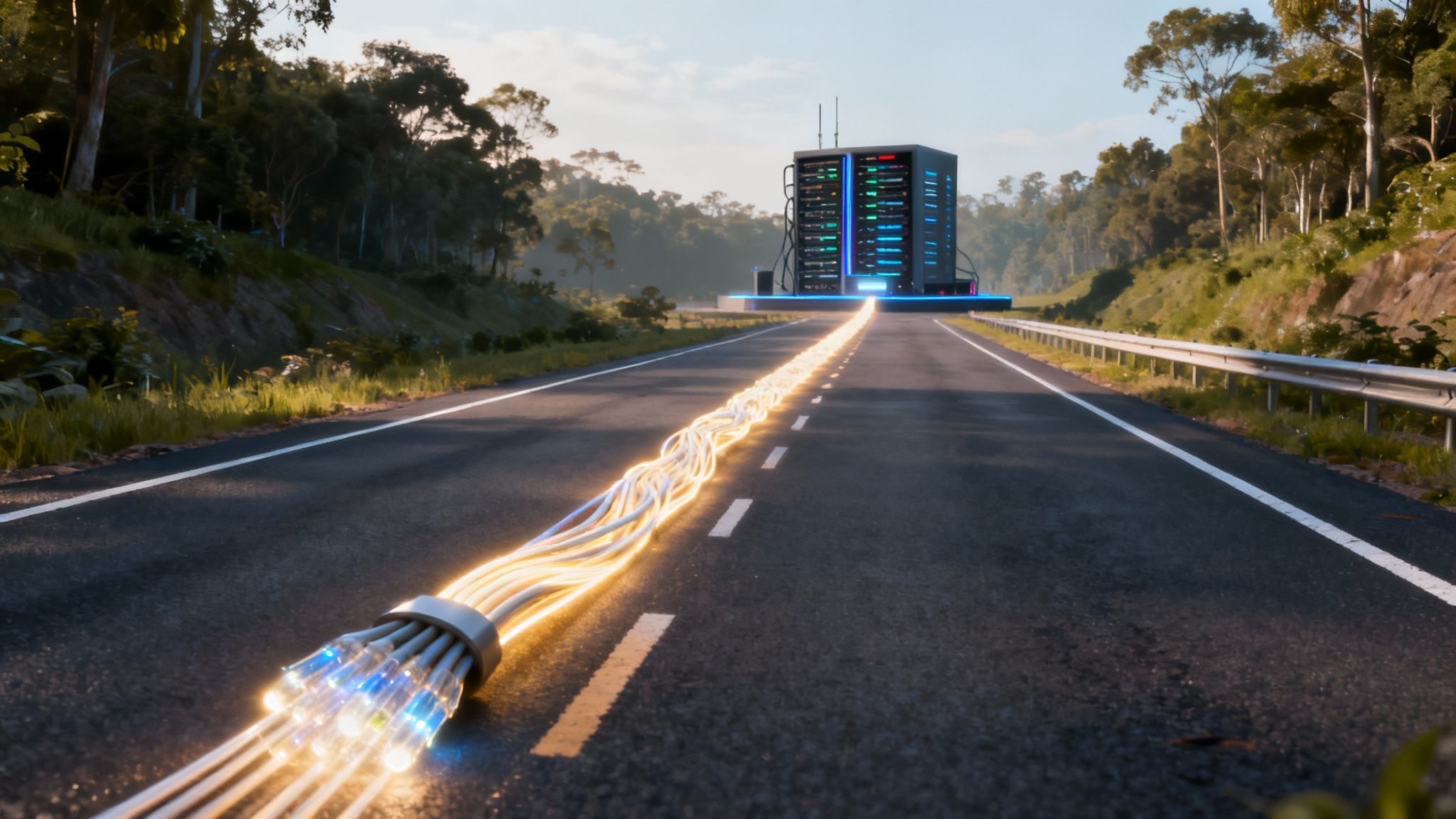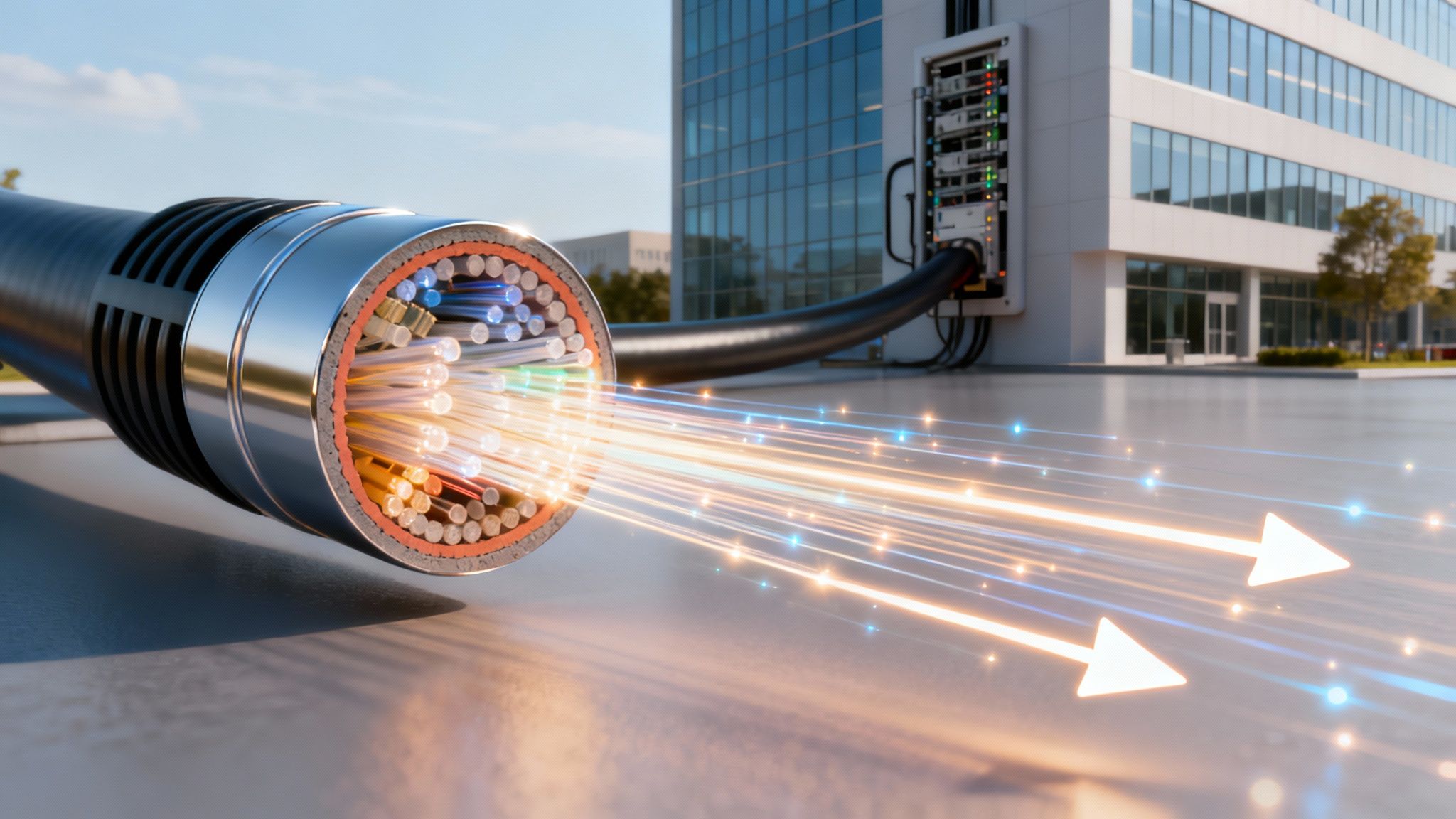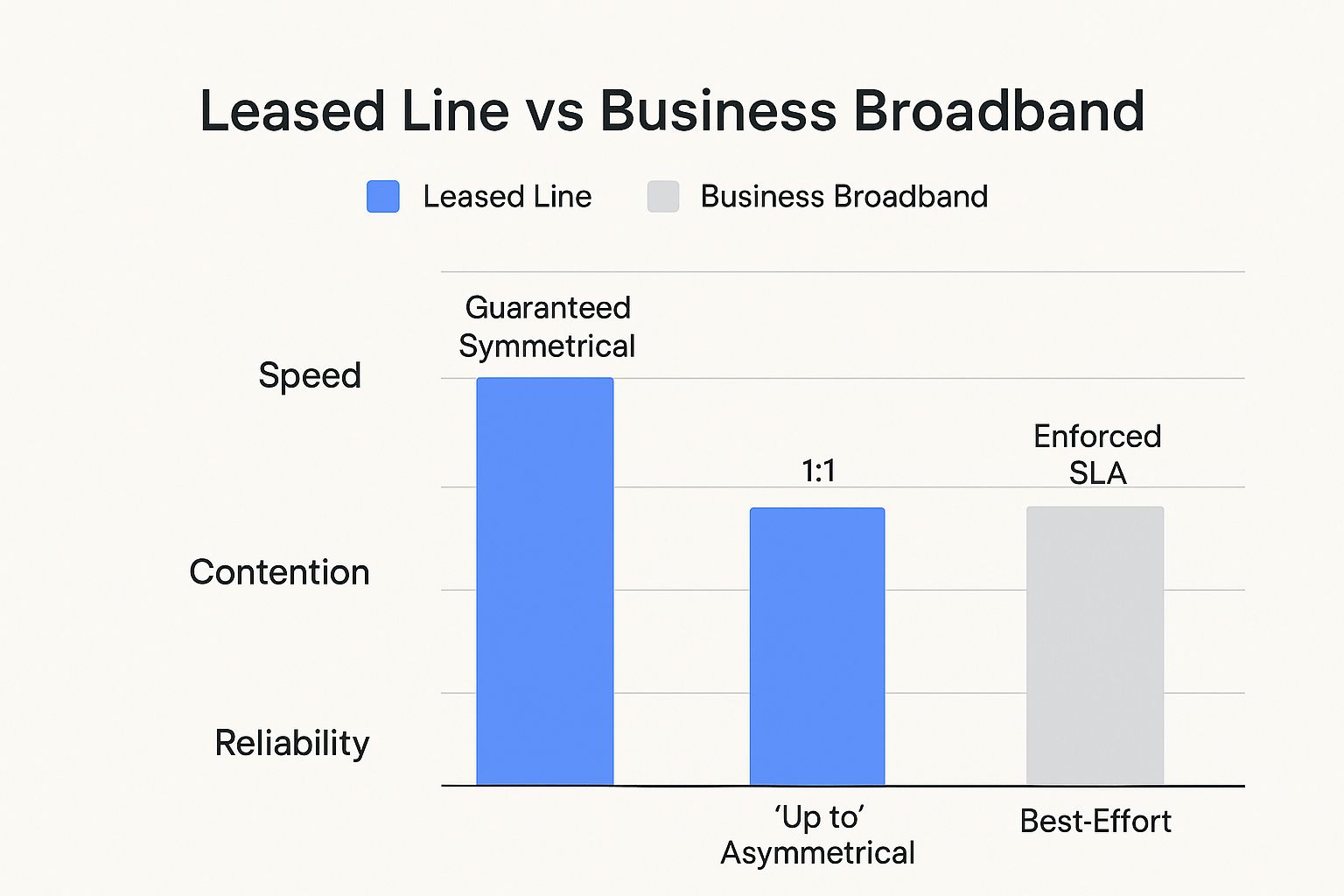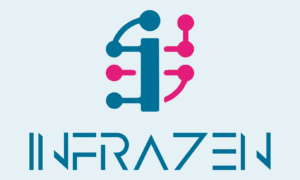Think of your standard business broadband as the M25 during rush hour. It’s a shared space, clogged with traffic, and your journey time is completely at the mercy of everyone else on the road. Now, imagine having your own private, clear motorway straight to your destination. That’s a leased line.
It's a private and dedicated fibre optic connection built exclusively for your business. No sharing, no traffic jams, just a direct, fast, and reliable route for your data.
Your Private Highway on the Internet

Unlike conventional broadband, a leased line circuit isn't carved up and shared with other businesses in your area. That dedicated nature is its superpower.
The connection runs directly from your office to the provider's network, creating what we call an 'uncontended' link. This simply means the speed you pay for is the speed you get, consistently, for both uploads and downloads.
The core promise of a leased line is refreshingly simple: you get the exact internet speed you pay for, with rock-solid reliability. It’s the go-to solution for businesses that simply can't afford slowdowns or outages.
This level of consistency is a game-changer for modern creative agencies and studios. When your entire day revolves around stable connections for video calls, cloud rendering, or sending massive files, you can finally eliminate the frustration of peak-time slowdowns that plague shared networks.
Key Characteristics of a Leased Line
The performance of a leased line boils down to a few foundational principles that set it leagues apart from standard internet services.
- Dedicated Bandwidth: The connection is 100% yours. Your performance is never impacted by what other businesses are doing online.
- Symmetrical Speeds: You get identical speeds for both uploading and downloading. This is critical for sending large creative assets, backing up to the cloud, or hosting video conferences without lag.
- Guaranteed Uptime: Providers back their service with a formal Service Level Agreement (SLA), often guaranteeing 99.99% uptime and promising rapid fixes if an issue ever crops up.
Costs and Market Trends in the UK
The UK market for leased lines has become surprisingly competitive over the last few years. Today, an entry-level 100Mbps leased line typically costs between £175 and £350 per month. Be aware that rural installations can sometimes command a premium of around 22%.
On the plus side, many providers now offer zero installation fees on 36-month contracts, which removes a significant upfront cost. The investment pays off, too-data shows that 87% of businesses report measurable gains in productivity after making the switch.
Of course, a leased line gives you a private physical circuit, but it's just as important to secure the data travelling over it. Our guide on what is a virtual private network explains a key technology that handles data encryption.
How Leased Line Technology Actually Works

To really get what a leased line is, you need to look under the bonnet. Your standard business broadband-even the fancy fibre options like FTTC or FTTP-is almost always a shared connection. Think of it like a public road; your data travels along the same routes as everyone else's, which is why you get traffic jams and slowdowns at busy times.
A leased line is completely different. It’s your own private motorway.
It uses a single, dedicated strand of fibre optic cable to connect your office directly to your provider's network exchange (often called a Point of Presence, or PoP). This direct, exclusive link is precisely why it performs so much better. It cuts out the two biggest headaches of shared connections: contention and asymmetrical speeds.
The Power of Zero Contention
Ever notice your internet slows to a crawl around 5 pm? That’s contention. You and all the other businesses in your area are competing for the same slice of available bandwidth. When everyone tries to use the internet at once, everything grinds to a halt.
A leased line has a contention ratio of 1:1. This is just a technical way of saying you share it with no one.
Because the line is exclusively yours, the speed you pay for is the speed you get. Always. It doesn't matter if every other business on your street is streaming 4K video-your connection remains constant and predictable, 24/7.
This rock-solid consistency is non-negotiable for any business running mission-critical applications that simply cannot afford to drop out.
Symmetrical Speeds Explained
Standard broadband connections are asymmetrical, meaning they are built for much faster downloads than uploads. That’s fine for watching Netflix at home, but it’s a serious bottleneck for a business.
Creative teams are constantly pushing data out: uploading huge files, running high-definition video calls, and backing up projects to the cloud. A leased line delivers symmetrical speeds, so your upload speed is identical to your download speed.
Let’s put that into context:
- 100Mbps Download / 100Mbps Upload: A design agency can fire a massive video file over to a client just as quickly as they can download assets. No more watching a progress bar crawl for hours.
- 1Gbps Download / 1Gbps Upload: A production studio can host a crystal-clear video conference with international clients while simultaneously backing up terabytes of project files to a remote server, without a single stutter.
This balance is fundamental to a modern creative workflow. It ensures your team's productivity isn't choked by sluggish uploads-a common pain point with shared broadband. This stability is a core pillar of effective IT infrastructure, a topic you can dive deeper into by reading about the importance of IT infrastructure management.
Leased Line vs Business Broadband Head-to-Head
Picking the right internet service for your business can feel like navigating a minefield of jargon. But really, it all boils down to one simple question: do you need your own private, guaranteed connection, or can you get by on a shared, public one?
That’s the core difference between a leased line and standard business broadband.
To make the choice clearer, let's put them side-by-side. We’ll look at the features that actually matter to your day-to-day operations. Each one is built for a different job, and they come with very different trade-offs in performance, reliability, and cost.
This chart gives you a quick visual on the main differences.

As you can see, a leased line is all about guaranteed, symmetrical performance. Broadband, on the other hand, is a "best-effort" service with speeds that can fluctuate.
Let's break that down with a simple comparison table.
Leased Line vs Business Broadband at a Glance
This table strips away the noise and puts the key features in a direct head-to-head comparison, showing you exactly what you get for your money.
| Feature | Leased Line | Business Broadband (FTTC/FTTP) |
|---|---|---|
| Connection Type | Private, dedicated fibre optic circuit | Shared, public connection |
| Speed | Symmetrical (same upload/download) | Asymmetrical (faster download than upload) |
| Speed Guarantee | Guaranteed and consistent | Variable, 'up to' advertised speeds |
| Contention Ratio | 1:1 (uncontended, 100% for you) | 20:1 or higher (shared with other users) |
| Service Level Agreement (SLA) | Yes, with guaranteed uptime and fix times | No, service is provided on a 'best-effort' basis |
| Typical Fix Time | 4-6 hours | Can be days |
| Security | Inherently secure due to private circuit | Public network, requires more security measures |
| Cost | Higher monthly cost | Lower monthly cost |
Ultimately, the choice comes down to whether your business can tolerate unexpected downtime and variable speeds. For many, the reliability of a leased line is an investment, not just a cost.
Speed and Performance
The most glaring difference is in the speed. A leased line delivers symmetrical speeds, which is a game-changer. It means your upload and download speeds are identical. If you pay for a 100Mbps leased line, you get 100Mbps up and 100Mbps down. This is absolutely critical for creative teams uploading huge files or holding flawless video calls.
Business broadband is completely different. It's asymmetrical, so your download speed is always much higher than your upload. The 'up to' speed you're sold is also shared with lots of other local businesses, which means performance can plummet during busy periods.
Reliability and Service Guarantees
This is where the two services really part ways. Leased lines are backed by a rock-solid Service Level Agreement (SLA).
An SLA isn't just a promise; it's a contract. It guarantees key performance metrics like uptime-often 99.9% or higher-and promises a target fix time, usually within just 4-6 hours, if anything goes wrong.
Business broadband runs on a 'best-effort' basis. Your provider will try their best, but there are no contractual guarantees on uptime or how quickly they’ll fix a problem. For any business where connectivity is mission-critical, that’s a huge gamble.
Contention and Security
The contention ratio is a simple way to understand the private vs. public difference. A leased line has a 1:1 contention ratio. The line is yours and yours alone. 100% of the bandwidth is dedicated to your business, 24/7.
Standard business broadband can have a contention ratio of 20:1 or even more. You’re sharing that connection with at least 20 other customers, and that’s why your speeds slow to a crawl at 3 PM. Because a leased line is a private circuit, it's also much more secure right out of the box than a public broadband network.
For businesses that need to take security and network performance to the next level, it's worth seeing how SD-WAN managed services can be layered on top of a leased line to create an incredibly powerful and resilient network.
Why Your Business Might Need a Leased Line

Let’s move past the technical jargon. The real question is, what does a dedicated connection actually do for your day-to-day operations? A leased line isn’t just about getting faster internet-it’s about removing the technical friction that slows your business down and costs you money.
For creative teams, this is a game-changer. The guaranteed symmetrical speeds mean uploading massive design files, video renders, or architectural plans is no longer a day-ending task. It happens just as fast as downloading them.
Suddenly, your team can move on to the next billable project instead of staring at a progress bar. This consistent performance builds a rock-solid foundation for all your modern tools.
Empowering Critical Business Operations
When your connection is predictable, every online interaction becomes smoother and more professional. This stability is absolutely vital for organisations that rely on real-time communication and cloud-based software every single day.
Think about these common scenarios where a leased line makes all the difference:
- Crystal-Clear VoIP and Video Calls: It eliminates the stuttering, lag, and dropped calls that can derail important client meetings and frustrate internal collaboration.
- Seamless Cloud Software Access: Whether your team lives in Office 365, Salesforce, or Adobe Creative Cloud, low latency ensures these applications are responsive and always available.
- Robust Remote Access: Give your remote and hybrid workers fast, secure access to company servers and files, keeping them productive no matter where they are.
A leased line is an investment in your operational resilience. It's about eliminating costly downtime and ensuring your business can function without interruption-a core part of any solid business continuity plan for IT.
Building a Foundation for Growth
As businesses depend more on data-heavy applications, the demand for high-performance connectivity is only going one way. The UK's B2B fixed connectivity market, which includes leased lines, is projected to grow from USD 2.88 billion in 2025 to a huge USD 3.72 billion by 2030.
This growth is being driven by the tech sector's needs and the widespread move to cloud services, with 84% of UK businesses now adopting a 'cloud smart' approach.
This trend highlights a crucial point: your internet connection is no longer just a utility. It's a strategic asset. For businesses that need efficient system integration across different platforms and locations, a reliable network isn't a luxury; it's the foundation for modern efficiency.
Choosing a Leased Line Provider in the UK
Finding the right leased line provider isn't just about chasing the lowest monthly price. Think of it as choosing a business partner-one you’ll rely on every single day to keep your operations running smoothly. The first step is getting a feel for the market, which is a mix of the big, established carriers and a wave of nimble, challenger networks.
The major players often own the physical fibre in the ground, but don't discount the smaller, specialist providers. They can often deliver far better customer support and more flexible contracts. Before you sign anything, it’s worth checking out what other top business internet providers are offering. This gives you a solid benchmark and helps you ask the right questions.
Key Questions for Potential Suppliers
To get past the glossy sales pitch, you need to dig into the practical details. These are the things that will actually matter once the ink on the contract is dry.
- What are your realistic installation times? Don't accept a vague answer. Ask for an estimate tied directly to your postcode, because lead times can vary wildly from one street to the next.
- Can you walk me through the fine print in your SLA? You're looking for a guaranteed fix time-ideally 4-6 hours. You also need to know exactly what the compensation process looks like if they fail to meet it.
- What is your customer support really like? Is it based in the UK? Will you be speaking to a technical expert who can actually solve your problem, or just a call centre agent reading from a script?
- How flexible are your contracts? Ask about the process and costs involved if you need to upgrade your speed down the line. A good provider makes this easy.
The Rise of Challenger Networks
For years, the UK leased line market was dominated by a handful of big names. That’s changing. A new breed of "challenger networks" is seriously shaking things up, and it’s fantastic news for businesses.
CityFibre, for example, is pushing its network into over 60 UK cities, offering mind-bendingly fast leased lines from 1Gb all the way up to 100Gb. Others like Vorboss in London and ITS are doing the same, often with much faster installation times and sharper pricing.
This surge in competition is forcing everyone to innovate, making high-speed, reliable connections more accessible than ever before. It's well worth exploring how challenger networks are disrupting the UK leased line market to see how they're filling the gaps left by the bigger players.
Understanding the Leased Line Installation Process
Ordering a leased line isn't like getting your home broadband sorted. It’s a far more involved affair, and knowing what to expect from the start helps manage everyone's expectations. This isn't a "plug-and-play" service; it's a piece of dedicated infrastructure being built just for your business.
That’s why the lead times can feel long, often ranging from 30 to 90 days-and sometimes even longer. The journey from placing your order to going live is a structured process involving surveys, potential digging, and careful testing. By understanding this path, you can prepare your premises and plan your project timelines to ensure a smooth switch to your new high-performance connection.
The Initial Site Survey
Once you’ve placed an order, the first crucial step is the site survey. A team of engineers will visit your premises to meticulously plan the physical route for the new fibre optic cable. They’ll assess everything from the nearest network point on the street right up to the specific entry point into your building.
This survey is vital because it determines the real scope of the work. The engineers will identify any potential roadblocks-literally, sometimes-like roads, private land, or existing utilities that need to be navigated. The findings from this survey form the blueprint for the entire installation and give you a much clearer idea of the final timeline.
The site survey is the most critical planning phase. It uncovers the precise work needed to connect your building to the core network, including whether any significant civil engineering work is required.
After the survey, you'll get a report detailing the proposed plan. This is your chance to ask questions and make sure you’re happy with how the service will enter your property before any major work kicks off.
Civil Works and On-Site Installation
If the survey reveals there’s no existing ducting to your building, then civil engineering works may be needed. This is usually the part of the process that takes the most time. It can involve digging trenches across car parks or pavements to lay new ducting for the fibre cable.
Your provider handles all the planning permission and council coordination, but this essential groundwork is the most common reason for longer lead times.
Once the physical path is ready, engineers will pull the fibre optic cable through to your premises and install the necessary on-site equipment. This typically involves fitting a network termination point on the wall where the fibre enters your building. From there, they'll connect it to a managed router or other network hardware.
Finally, the connection is rigorously tested. Engineers run diagnostics to ensure the circuit is stable, performing at the speeds you've paid for, and meeting all the strict parameters of your Service Level Agreement (SLA). Only after it passes every single test is the line declared live and handed over to you.
Your Leased Line Questions Answered
Even with a good grasp of the basics, a few practical questions always come up. Let's get straight to the point and tackle the most common queries we hear from businesses weighing up their options.
Think of this as the final checklist to help you move forward with confidence, covering the things that really matter: cost, reliability, and what happens when your business grows.
How Much Does a Leased Line Cost in the UK?
There’s no single price tag, as the cost hinges on your speed, your postcode, and how long you commit for. As a rough guide, a 100Mbps leased line will typically start somewhere between £175 and £350 per month.
It’s true that businesses in more rural spots might see higher quotes due to the engineering work needed to get the fibre to their door. The good news? Many providers now offer free installation on 36-month contracts, which can easily save you £1,500 or more in upfront fees. Always ask for a quote specific to your location.
What Does a Leased Line Service Level Agreement Actually Cover?
The Service Level Agreement, or SLA, is where your provider puts their money where their mouth is. It’s not just marketing fluff; it's a binding contract that guarantees the quality of your service.
A solid SLA will clearly define:
- Uptime: This is almost always guaranteed at 99.9% or higher, meaning your connection is practically bulletproof.
- Performance Metrics: It sets firm targets for things like latency (the delay in data transfer) and packet loss, ensuring a consistently high-quality connection.
- Target Fix Time: This is the big one. It’s a promise to fix any fault within a specific timeframe, often as little as 4-6 hours.
If your provider ever fails to meet these promises, you get compensated with service credits. It’s a financial guarantee that they take your connection as seriously as you do.
Are Leased Lines Really More Secure Than Broadband?
Yes, fundamentally so. A leased line is a private, dedicated circuit built just for your business. Your data isn’t jostling for space on the public internet with countless other users.
This physical separation acts as a powerful first line of defence. It dramatically cuts the risk of certain cyber-attacks that prey on shared networks. You’ll still need firewalls and proper security hygiene, of course, but the private line itself gives you an incredibly secure foundation to build on.
Can I Increase My Leased Line Speed Later On?
Absolutely. In fact, this is one of a leased line’s biggest strengths. Most of the time, the physical fibre cable installed-known as a 'bearer'-has a much higher capacity than the service you initially pay for. For instance, you could order a 100Mbps service that runs over a 1Gbps bearer.
This means that when you need more speed, it’s usually just a simple software tweak your provider can handle remotely. No digging, no disruption. Your connection can scale up right alongside your business, smoothly and quickly.
At InfraZen Ltd, we specialise in creating calm, reliable, and future-proof technology for creative businesses. If you're ready to invest in a connection that just works, let's talk about building the right IT foundation for your team. Find out more at https://infrazen.tech.

